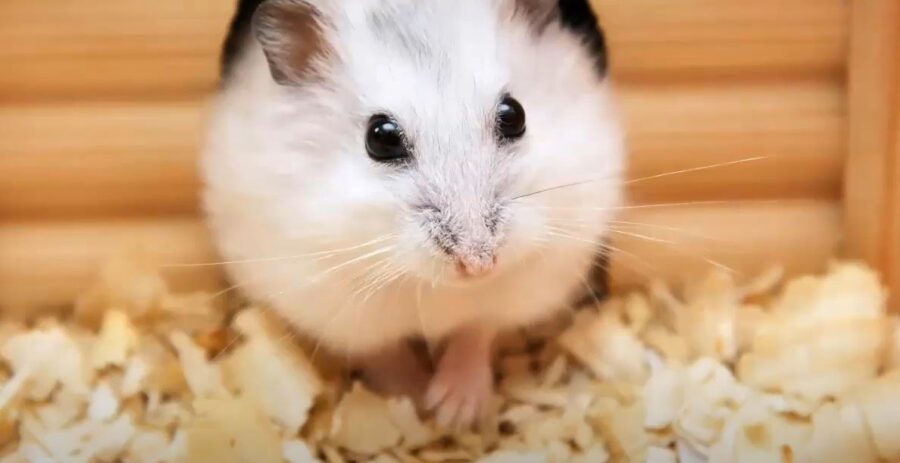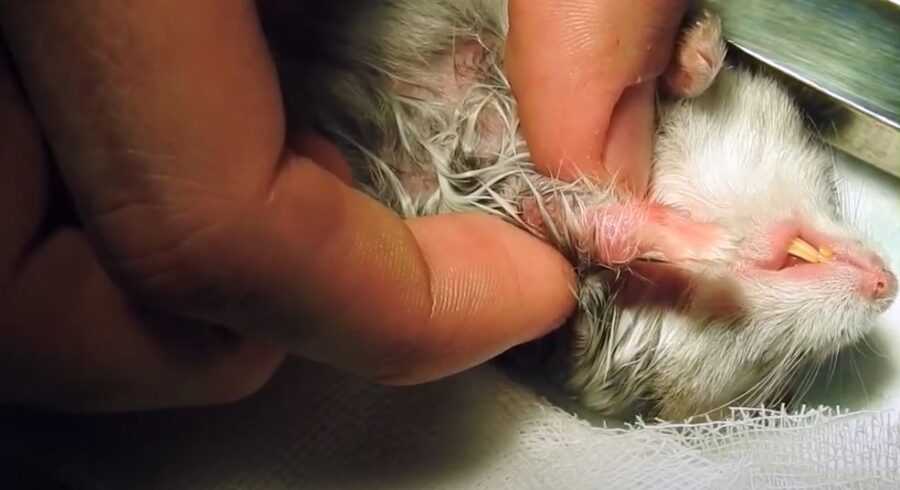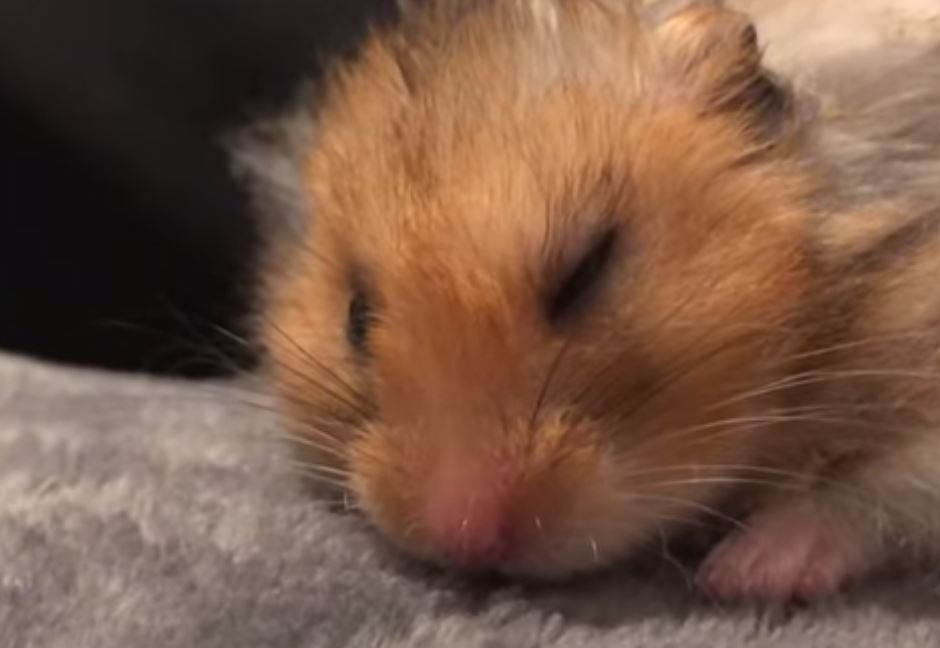The word bumblefoot doesn’t sound nearly as bad as what it actually is. Let’s talk about how to treat bumblefoot in hamsters.
This infection can range in severity and could be treated with mild medications, bandaging to surgery. Is bumblefoot contagious to humans? What are the stages of bumblefoot in hamsters?
In this article, we’ll dive into the steps and signs of this infection to find out how to treat bumblefoot in hamsters.
How to Treat Bumblefoot in Hamsters
This is an actively infected wound that needs management at home and treatment options directed by the vet. Warm feet soaks, daily bandaging and medication involving antibiotics coupled with pain meds are part of the treatment process.
Patience, diligence and routines to get through this process without resorting to surgery is the goal, but you have to trust your vet’s opinion on moving forward with treatment if symptoms of bumblefoot persist and worsen.

How Do You Treat Bumblefoot at Home?
Bumblefoot in hamsters can be treated at home if symptoms do not get worse. A vet should inspect the wound first, but you can address the problem right away and continue with the following steps mentioned below:
- Clean up the wound.
- Remove scabs.
- Squeeze out puss.
- Dry it.
- Apply antibiotic ointment.
- Bandage the wound.
- Repeat 1-2 times a day.
Why Does My Hamster Have Bumblefoot?
Bumblefoot (ulcerative pododermatitis) occurs often when poor husbandry practices like irritating surfaces including mesh on wheels or substrates along with poor sanitation lead to wounds that get infected.
Bacteria builds up and the bumblefoot infection gets worse before you know it. Your hamster may have cut a foot slightly, but it wasn’t noticeable. The interaction with bacteria present in the cage allowed for this infection to settle in and spread.
Can Bumblefoot Heal Itself?
In most cases bumblefoot afflicted hamsters do not end up with 100% recovery. This is because after the infection, healing needs more time and your hamster shouldn’t be walking on it, but it is very difficult to force your hamster to rest.
Mild cases of bumblefoot will heal much faster with barely any scarring, but a moderate to serious case of this infection could remain visible on the limbs of your hamster for the rest of their life.
What is Hamster Bumblefoot?
Bumblefoot (ulcerative pododermatitis) is a bacterial infection that is very common in:
- rodents
- birds
- rabbits
This infection is bacterial and causes inflammation. The bacteria involved in bumblefoot include:
- Staphylococcus
- Pseudomonas
- Escherichia
- S. aureus
The most common causes of this infection for hamsters is due to their feet making contact with bacteria that spreads and enclosures that aren’t maintained for cleanliness and safe husbandry practices.
Wire mesh, degraded surfaces on old hamster wheels and many more examples of irritating and scratchy bedding or sharp substrates can influence the spread of harmful bacteria buildup into the limbs of your beloved hamsters and other pocket pets.

Is Bumblefoot Contagious to Humans?
The actual diagnosis of bumblefoot cannot be given to humans. However, one of the most prevalent bacterial infecting organisms included in bumblefoot is known as staphylococcus, commonly referred to as a staph infection.
This bacteria can transfer from infected hamsters, birds and other rodents. When your pet is experiencing a bacterial infection, you should handle with care by wearing gloves and washing up immediately afterwards.
Is Bumblefoot Common in Hamsters?
No. Bumblefoot is not as common in hamsters as it is for birds, but that doesn’t mean that won’t happen in times of poor husbandry or hygiene. The disease known as bumblefoot is also referred to as Pododermatitis where the foot is inflamed and infected.
Symptoms of Bumblefoot
Common symptoms include:
- red or sore feet
- inflamed bumps
- scabbing
- pus build up
If your hamster was infected with bumblefoot this means the bacterial infection was present in a surface that they stepped on. They may have scraped or cut their feet and the bacteria made contact with open wounds.
Bumblefoot can over grow and spread across the foot end range in severity that can lead to surgery as a worst-case scenarios. Unfortunately, many animals can suffer to the point where they need to be put down.

Home Remedies For Bumblefoot
Bumblefoot can be treated at home by using some of the following items or ingredients that you may have lying around your home.
Although we do recommend some of the suggestions below, we still believe that a visit to the vet is important when trying to treat a bacterial infection that could spread or possibly get worse.
Do you have any of the following in your home?
- Epsom salt
- vitamin C
- antibiotics
- bandages
- hydrogen peroxide
If you notice positive results by soaking your hamsters feet in Epsom salt, enriching their diet or water with vitamin c-rich foods and droppers may help.
Bandage the wound after applying antibiotic ointment to treat this condition at home. If the wound is not healing, please visit the vet as soon as you can.
Factors Cause Bumblefoot in Hamsters
If your hamster is overweight, this is a big problem that leads to more pressure being placed on delicate limbs and feet.
The more pressure from the weight above the foot, the higher the likelihood that pain or inflammation can set in these limbs. Coupling that with an unhygienic environment can lead to hamsters developing bacterial infections.
Finally, if your hamster is commonly walking on wired floors that can lead to cuts or scrapes, the bacteria present can seep into these minor wounds.
The cut could end up turning into a larger infection that take much more time to heal and can spread if untreated.
What Happens When a Hamster Has Bumblefoot?
A hamster with bumblefoot can develop ulcers on the feet. Inflammation can lead to swollen lymph nodes and arthritis. In worst case scenarios amputation or surgery is necessary.
Bumblefoot can spread as a bacterial infection across the body that may lead to fatality or the decision to put down your pet.
Consult with the veterinarian for the best possible treatment solutions when bumblefoot continues to get worse in severity.
Stages of Bumblefoot in Hamsters
Stage 1
You might notice light swelling or redness. Areas of the feet may look red or patchy.
Stage 2
Inflammation starts to get worse and redness is very obvious on the pads of the feet. Your hamster may be walking gingerly.
Stage 3
The infection is getting worse and your hamster is in noticeable pain. He or she is unable to move the paws or walk. The red patches can turn brown. Puss and scabs begin to develop in these infected areas.

Manuka Honey For Bumblefoot
You might find a recommendation to use Manuka honey as an antibacterial antiseptic for treating bumblefoot.
You can prepare Manuka honey baths and even apply Epsom salt in this warm water as well. Soak your hamster’s foot in this honey bath twice a day.
You can also continue to feed your hamster drops of vitamin C manually or drop it in your hamster’s water.
How to Avoid Bumblefoot?
Rodents and birds are susceptible to developing bumblefoot inside their cages. Make sure the cage does not have a wire bottom or any abrasive bedding that could cause minor scratches.
These tiny little wounds can turn into bacterial infections. The cage or enclosure needs to be cleaned more often, especially in moist areas.
Bacterial growth is encouraged in areas where temperatures are warm and humid. A weekly cleaning schedule will be recommended by a veterinarian to be proactive against this disease.
Treatment Tips For Bumblefoot
- Clean the wound.
- Address the issue by going to the vet.
- Apply ointment.
- Soak the feet in a warm bath.
- Add Epsom salt in the bath.
- Add a few drops of Manuka honey into the bath.
- Drop vitamin C into your hamster’s water to boost the immune system.
- Remove scabs and squeeze out puss.
- Give your hamster painkillers prescribed by the vet.
- Use antibiotic creams that are also prescribed.
- Clean the enclosure thoroughly.
- Replace bedding more often.
How Do You Get Rid of Mange on Hamsters?
Mange on hamsters occurs when there are parasitic infections or mite infestations. There are multiple methods of getting rid of mange on hamsters that will be recommended or prescribed by your hamster’s veterinarian.
Here are a few treatments:
- topical application with mite-killing dusts and sprays
- shampoos that contain selenium sulfide
- ointments containing amitraz
Conclusion
Bumblefoot occurs when there are poor husbandry errors made by owners or breeders. Hamsters can be housed or raised in wire bottom cages that create abrasions from the mesh or the use of rough bedding.
It’s important to make sure that the bedding is changed more often and the cages are cleaned thoroughly each week.
We hope your hamster recovers and resumes active engagement and joyful living with you in your safe, clean and comfortable home environment.
Thank you for visiting PocketPetCentral.com for the best information to help you enjoy the life of your pocket pet companion in a fun, safe & healthy way.

